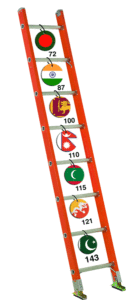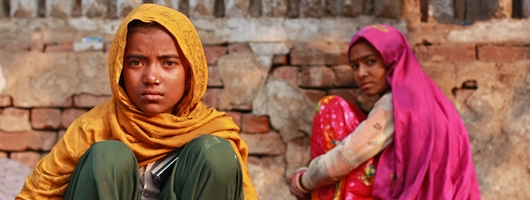Bottom of the Ladder?
By Hilda Saeed | Health/Medicine | Published 8 years ago
 Pakistan ranks 143 out of 144 countries according to the gender ranking on the World Economic Forum’s (WEF) Global Gender Gap Report 2016, just ahead of Yemen, and shockingly, ranks lower than Saudi Arabia (141), which does not allow women to drive or to travel without a male relative’s consent, and Syria (142), engaged in a bitter civil war, where notions of gender are probably not uppermost in anyone’s mind. The WEF measures gender equality globally each year, and bases its findings on the degree of women’s empowerment in four major areas: Politics, Economy, Health and Education.
Pakistan ranks 143 out of 144 countries according to the gender ranking on the World Economic Forum’s (WEF) Global Gender Gap Report 2016, just ahead of Yemen, and shockingly, ranks lower than Saudi Arabia (141), which does not allow women to drive or to travel without a male relative’s consent, and Syria (142), engaged in a bitter civil war, where notions of gender are probably not uppermost in anyone’s mind. The WEF measures gender equality globally each year, and bases its findings on the degree of women’s empowerment in four major areas: Politics, Economy, Health and Education.
Based on these objectively verifiable indices, Pakistan emerges as the worst performing state in South Asia, and the second worst worldwide — a big comedown from 2006, when Pakistan ranked 112 on the same index. In South Asia, Bangladesh now ranks highest at 72, ahead of India (87), Indonesia (88), China (99), and, most surprisingly perhaps, Sri Lanka (100).The Nordic countries and Ireland have virtually closed the gender gap.
The WEF gender rankings are based on publicly available data. What does not make sense is how Pakistan can be ranked so low behind countries like Saudi Arabia, that are blatantly misogynistic. One reason could be the fact that social indices such as Violence Against Women (VAW), freedom of movement etc., are not included.
In July 2012, the UN Country Team in Pakistan formally endorsed the One UN Pakistan Statement on Gender Equality. This unanimous decision, the first of its kind in the country, solidified the commitment of each UN agency to work towards gender equality through their respective organisations. Pakistan has expressed its commitment and support for this initiative, at both the national and global levels, by committing to rights-based international covenants such as the Convention to Eliminate Discrimination Against Women (CEDAW), and through progressive internal formulation of national laws, policies and programmes.
Article 38 of the Constitution ‘guarantees citizens the right to pursue economic opportunities irrespective of sex, caste or creed.’ The Government of Pakistan’s principal planning document, Vision 2025, recognises that expanding women’s participation and access to opportunities are central to sustained economic and social development, but the WEF Global Gender Gap Report 2016 clearly shows the limited degree of economic empowerment that Pakistani women have achieved.
Although women’s economic participation has improved exponentially in the last 70 years, the country still remains the subcontinent’s worst performer. Women continue to be sidelined from mainstream economic activities, despite constitutional promises of equality for all, and also despite the fact that Pakistan is a signatory to the CEDAW and several other human rights instruments, all of which stress equality between women and men.
In education, the picture is slightly better, up a few notches to position 135. However, attaining universal female literacy will take time — the backlog of the uneducated population, with relatively low girls’ school enrolment and significant dropout rates is still too high, and the schools too few. Though overall school enrolment has increased, many more schools are needed.
Health sector findings are more heartening: Pakistan is one of the world’s top five most-improved countries. Health, survival and life expectancy have improved, but only slightly. Pakistan has moved up one rank, from 125 last year to 124 this year.
As far as political empowerment is concerned, despite the Pakistani women’s relatively increased political representation in parliament, there are still very few women at the ministerial level; moreover, though the agreed quota of 33 per cent seats in the local bodies was adhered to, women, for the most part, were deprived of finances to carry on development work in their constituencies. Women’s right to vote was reaffirmed in 1956; despite that, women are often barred from exercising this right. In a recent by-election, verbal agreement was reached among the main contenders of the Jamaat-i-Islami (JI) and the Awami National Party (ANP), that women should not be permitted to vote.
The JI chief’s defence of his anti-women, anti-democratic stance is unpardonable; he thinks women have more important work to do at home, like cooking for their husbands! Fortunately, civil society organisations fought for women once again and succeeded in reaffirming their right to vote.

As for the dream of Pakistan achieving gender equality, nothing, but nothing, makes a jot of difference to our policy makers, or to the prevailing mindset of society. We may have had the Muslim world’s first female prime minister, the youngest female Nobel laureate, a young filmmaker, Sharmeen Obaid Chinoy, who has won two Oscars, the determined Raana Liaquat Ali Khan who, immediately after Partition, came out and exhorted other women to come out to help in resettling refugees and, in the process, laid the foundation of social welfare in the country. She set up organisations like APWA, established schools and colleges and nursing schools for women and was a trailblazer for future generations of Pakistani women. Despite all these achievements — we now have brilliant female parliamentarians, academics, scientists, businesswomen, surgeons, doctors, teachers, a woman leader of an all-male trade union, air force pilots and more — we also have an unchanging patriarchal mindset and persistent gender inequality.
Why? What compels Pakistan to continue on this destructive path despite non-stop struggles by activists to eliminate inequitable norms and bring about legislation against the myriad forms of discrimination and abuse.
Change is excruciatingly slow; the odds still remain heavily stacked against women, as does their status of systemic gender subordination. That has continued irrespective of class, region, and rural or urban residence. As if that were not enough, tribal and feudal norms, extremist religious beliefs and hyper-masculinity contribute heavily to continuing patriarchal bias against women. Large numbers of women doctors and other highly qualified professional women are often coerced to leave their careers when they marry. Of those who do succeed in pursuing their careers, few are able to make it to the top: 98 per cent of the senior managers in banks, financial institutions and industrial units are male. Promotion of women’s economic participation requires initiatives that are sensitive to their needs, such as flexible working hours, maternity leave, and provision of baby crèches.
Progress in Pakistan continues, though at a snail’s pace. A partial reason is the country’s history of long stretches of militarisation, alternating with stop-and-start democracy. The Zia years have been largely responsible for furthering already deeply entrenched misogynistic attitudes, and rendering women the subservient sex. Since then, some positive change has been wrought, but not enough.
We’re all familiar with stories of discrimination against girls from infancy; of the marked preference for sons. The pattern may be changing in many families, but in the larger Pakistani milieu, “the importance of the male’’ is overwhelmingly clear, palpably visible. Male decision-making roles are more evident in conservative families: girls are rarely permitted to take independent decisions. They’re carefully guarded, their mobility restricted. They’re exhorted to cover up, to dress modestly. In short, there’s a host of rules and regulations governing female behaviour; gender inequality almost gets inbred into this pattern of life.
On the part of the state, there’s much cosmetic promotion of gender equity initiatives, but not enough policies and programmes to match in each of the four prioritised areas of political and economic participation, and health and education. Policies for women’s progress, equality and empowerment invariably take a backseat.
The introduction of the promising 18th Amendment, and greater provincial autonomy were positive steps. Nonetheless, there have been some unfortunate repercussions. The dissolution of the federal ministry of women’s development, youth and social welfare has led to unexpected problems. Earlier initiatives by the women’s ministry for improvement of women’s status in each of those four prioritised areas are now at a standstill. Provincial Women’s Development Departments have failed to fill the gap.
Nevertheless, despite these negative trends, women have made strides in parliamentary politics and lawmaking; at present, we have a total of 362 women in Parliament, with 121 in provincial legislatures, besides many other women councillors in the provinces. There’s a strong Women’s Caucus in Parliament, that works across political party divides to achieve favourable legislation for women; the National Commission on the Status of Women contributes significantly to the equalisation of women’s gender status, and ensuring justice for them.
Women are now also far more visible in the economic sphere; the gender gap is closing for health and education. Which is why it is difficult to comprehend why Pakistan is ranked even lower than Saudi Arabia and Syria.
The methodology evolved by the WEF to arrive at the gender rankings is said to be thorough; they have examined four areas of women’s empowerment: Political Empowerment, Economic Participation, Health and Education. By their own estimations, Pakistan has improved in the health and education sectors; certainly gender empowerment needs to be strengthened in the political and economic sectors — but it’s shocking that we’re placed so low on the gender ladder.
Globally, each country is required to attain a “just and sustainable” level of human development –and for that, as stressed by the WEF, gender equality is essential. According to the same report, the world is facing an acute misuse of talent by not acting faster to tackle gender inequality. And in Pakistan’s case, this could put economic growth at risk and deprive the national economy of the chance to progress.
Despite all these drawbacks, the Pakistani woman’s progress will become evident in the much awaited results of the 2017 Census. Past census periods of 1981 and 1998 indicate that a real transition is taking place in women’s lives: there has been a sharp decline in women’s marriage rates, an upward shift in the age of marriage, higher educational attainment, and an increase in divorce rates. In short, profound socio-economic changes are likely to emerge, and women will be the harbingers of the change.


